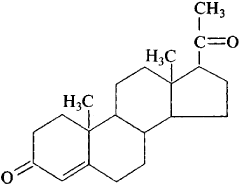progesterone
Progesterone
A steroid hormone produced in the corpus luteum and placenta. The hormone has an important physiological role in the luteal phase of the menstrual cycle and in the maintenance of pregnancy. In addition, progesterone produced in the testis and adrenals has a key role as an intermediate in the biosynthesis of androgens, estrogens, and the corticoids (adrenal cortex steroids). See Androgen, Cholesterol, Estrogen, Menstruation, Steroid, Sterol
progesterone
[prō′jes·tə‚rōn]Progesterone
in humans and vertebrate animals, a female sex hormone. Chemically, progesterone is a steroid that is synthesized in the body from cholesterol. It is an intermediate in the biosynthesis of all steroid hormones and can form in any tissues that secrete these hormones. Its structural formula is

In humans and higher animals, progesterone is primarily synthesized in the corpus luteum of the ovaries; the luteinizing hormone of the pituitary gland regulates its production. In the blood, progesterone mainly occurs in complexes with proteins.
By interacting with estriadol, another female hormone, progesterone regulates the estrous cycle in mammals and the menstrual cycle in humans. In the preovulatory phase of the sex and reproductive cycles in women, the daily production of progesterone occurs principally in the adrenal cortex and measures 1 to 3 mg. In the postovulatory phase, as much as 20 to 30 mg of progesterone are produced, principally in the corpus luteum. Progesterone produces changes in the uterine mucosa, which prepare the uterus for the implantation of the fertilized egg. When fertilization does not occur, the corpus luteum atrophies and the secretion of progesterone decreases. During a normal pregnancy, the placenta participates in the required daily production of as much as 200 to 250 mg of progesterone. Progesterone suppresses the activity of the smooth musculature of the uterus and thus prevents spontaneous abortion of the fetus; it also inhibits the ovulation of new follicles. The concentration of progesterone in the uterus decreases at the end of pregnancy, which serves as one of the trigger mechanisms of childbirth.
In medicine, progesterone and its synthetic derivatives (generally called progestins, or gestagens) are used to treat various disturbances of pregnancy and the ovarian cycle; they are also used in combination with estrogens as contraceptives. Derivatives of progesterone that act as repellents have been discovered in some insects. Flowering plants have also been found to produce progesterone.
In 1934, A. Butenandt contributed to the discovery of the chemical structure of progesterone.
REFERENCES
Savchenko, O. N. Gormony iaichnika i gonadotropnye gormony. Leningrad, 1967.Heftmann, E. M. Biokhimiia steroidov. Moscow, 1972. (Translated from English.)
B. V. POKROVSKII